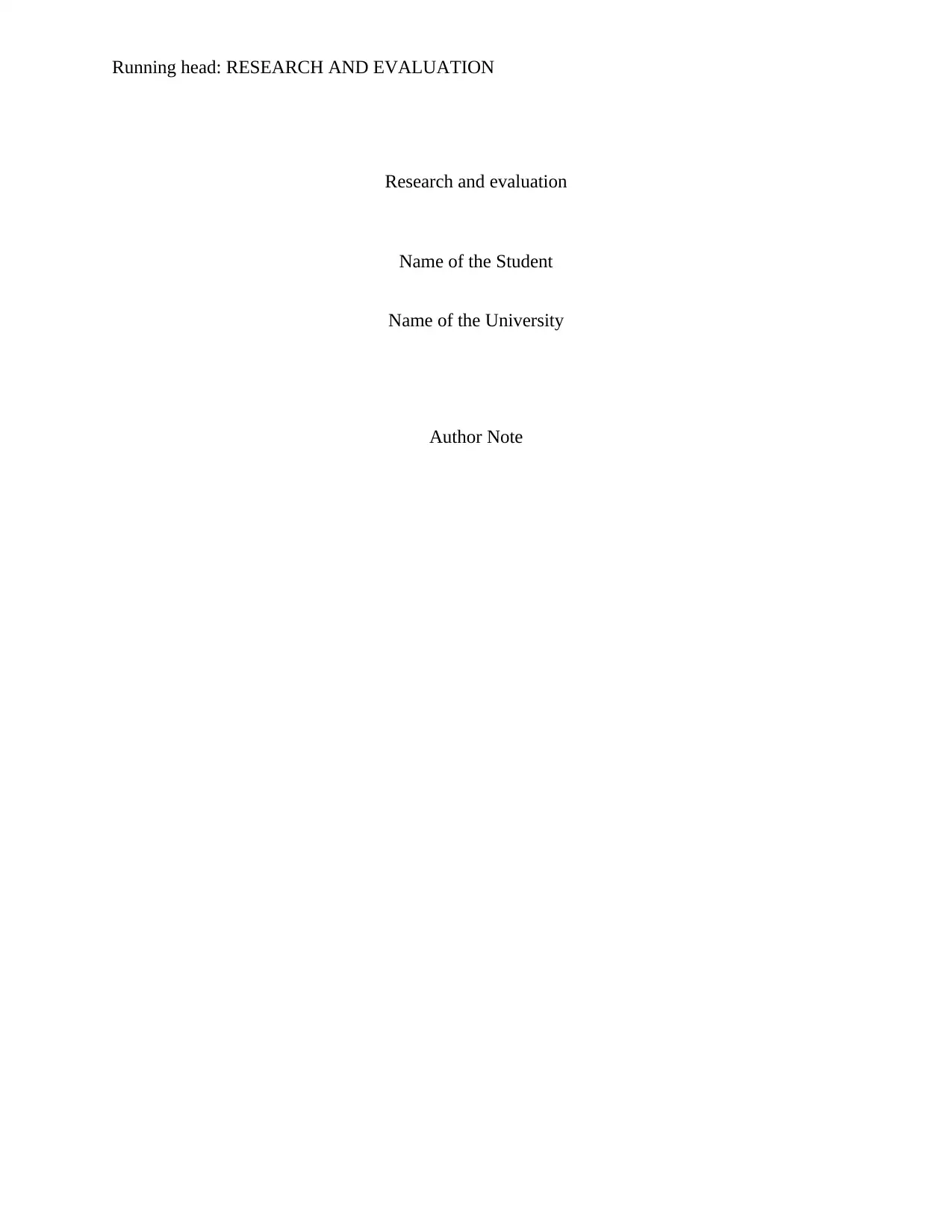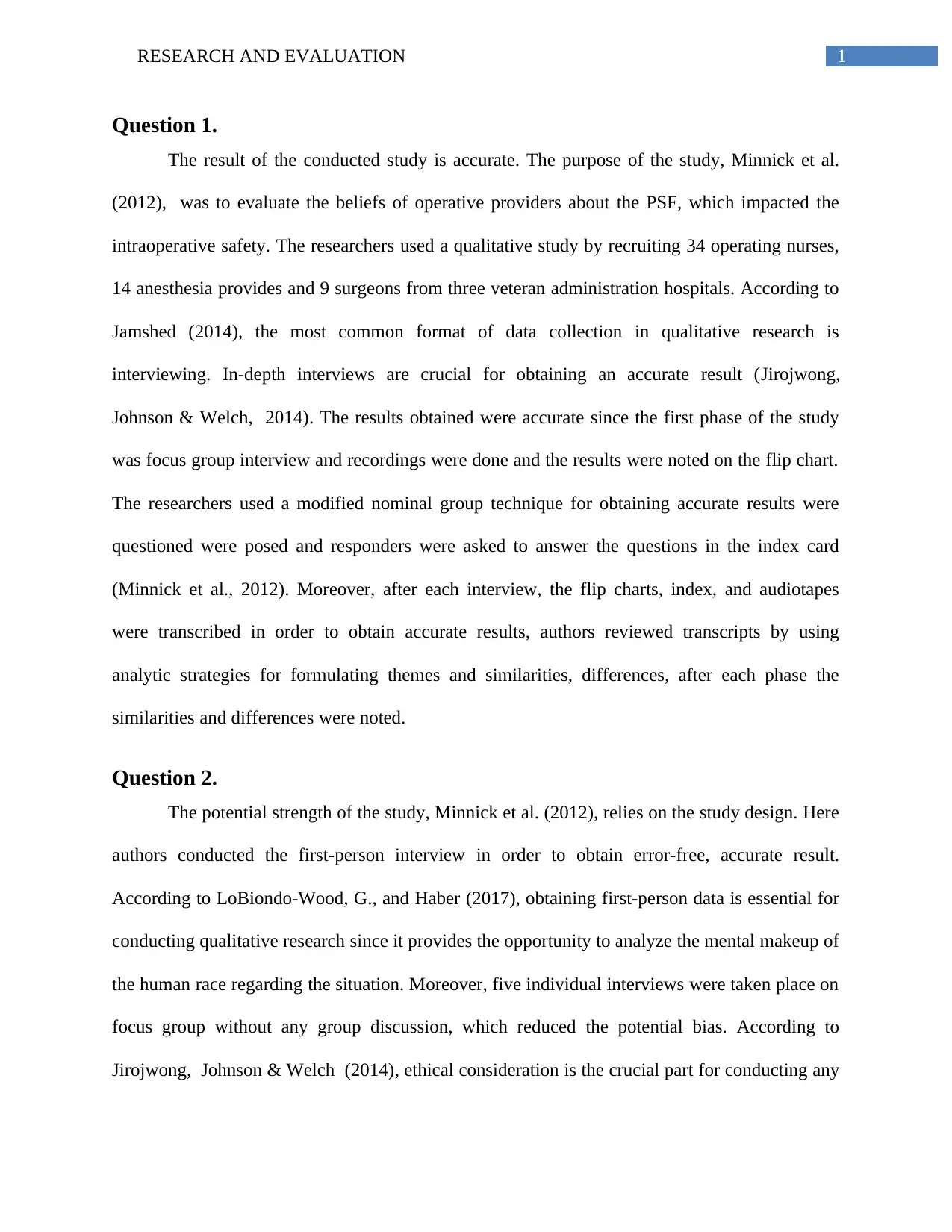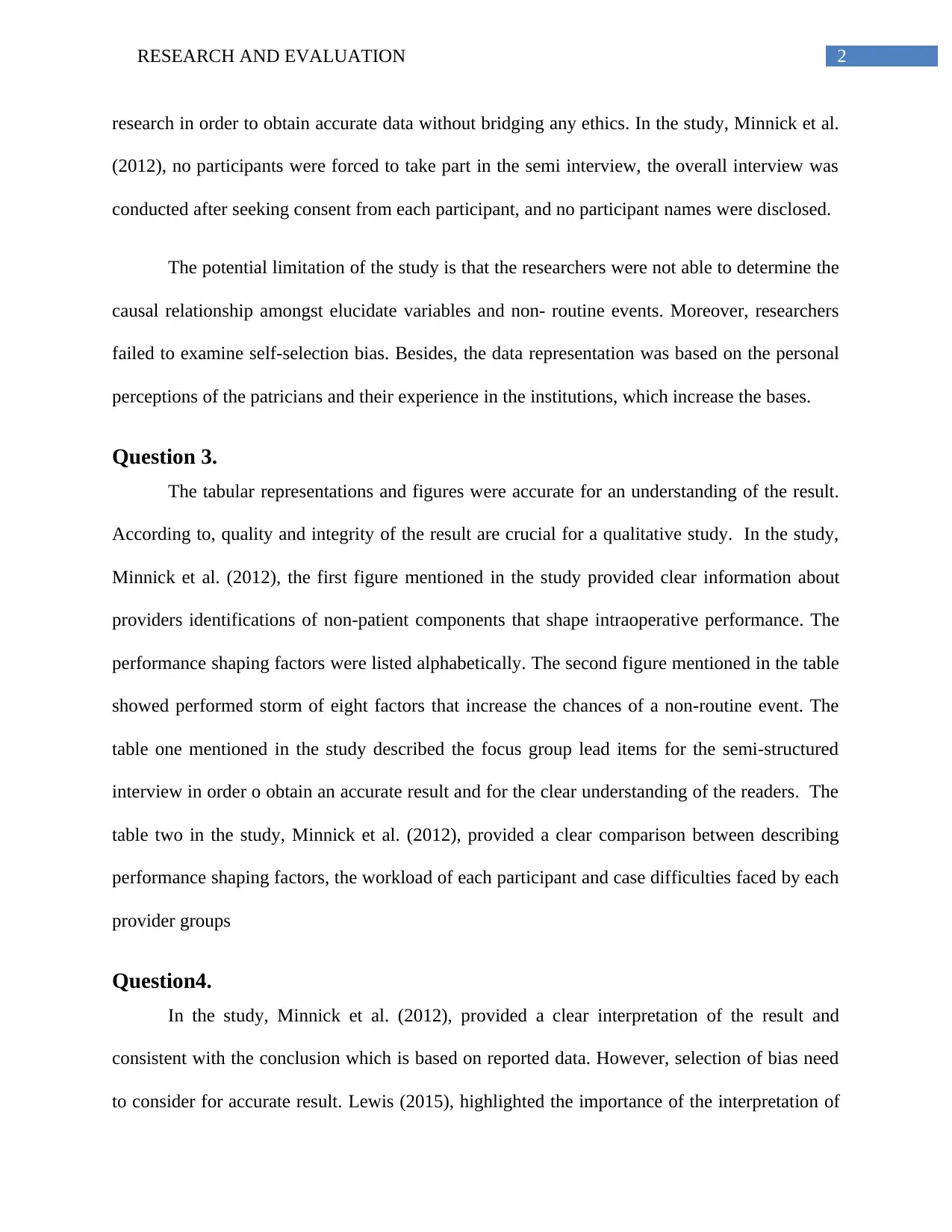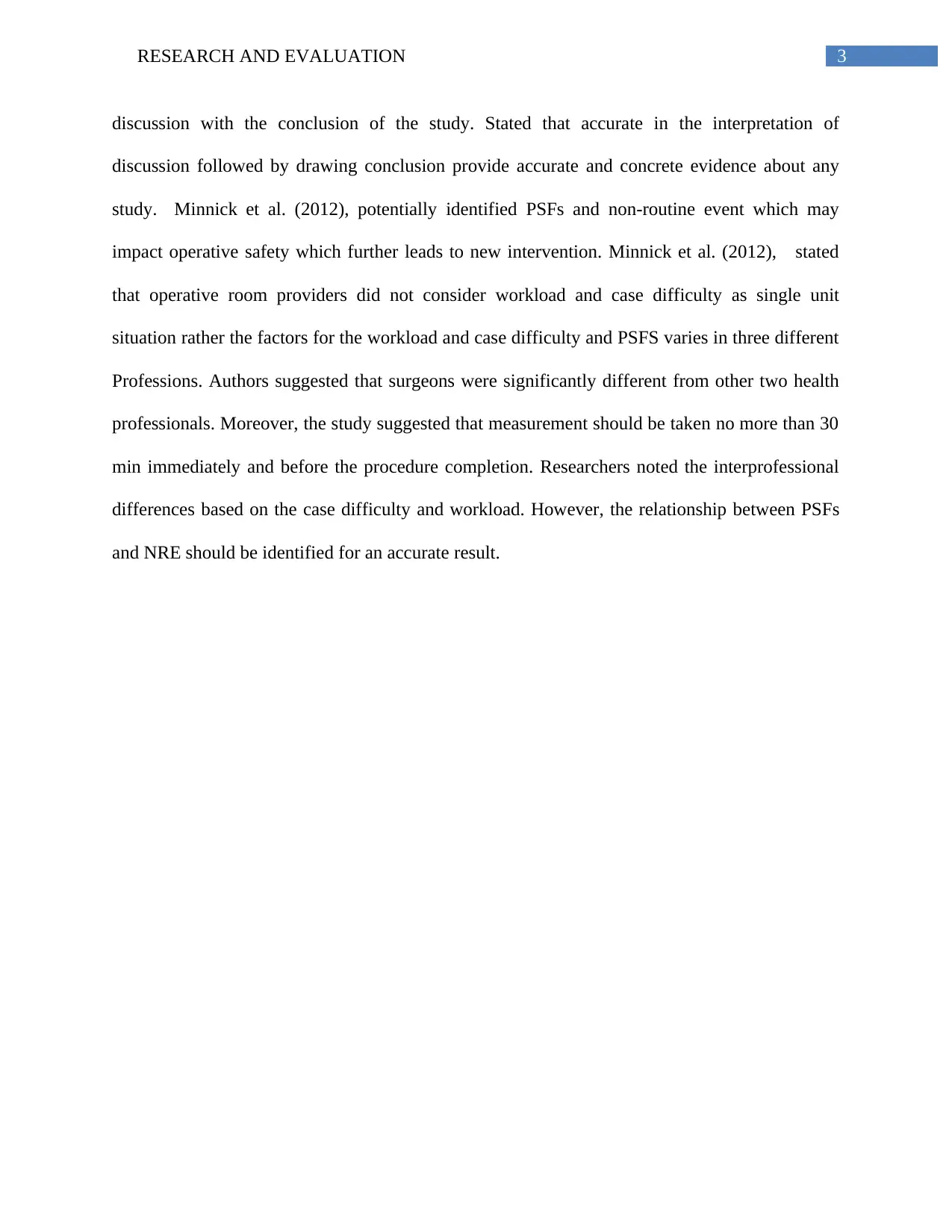Critical Appraisal: Research on OR Team Views - Workload & Difficulty
VerifiedAdded on 2023/05/30
|5
|1043
|346
Report
AI Summary
This report evaluates a research study by Minnick et al. (2012) concerning operating room (OR) team members' views on workload, case difficulty, and non-routine events. The evaluation assesses the accuracy of the study's results, highlighting the strength of the qualitative design, including first-person interviews and ethical considerations. Limitations, such as the inability to determine causal relationships and potential self-selection bias, are also discussed. The report further examines the clarity and helpfulness of tabular representations and figures, confirming their accuracy in conveying the results. Finally, the evaluation confirms the interpretation of results and consistency with the conclusions, while also noting the importance of addressing selection bias. Desklib provides access to this and other solved assignments for students.

Running head: RESEARCH AND EVALUATION
Research and evaluation
Name of the Student
Name of the University
Author Note
Research and evaluation
Name of the Student
Name of the University
Author Note
Paraphrase This Document
Need a fresh take? Get an instant paraphrase of this document with our AI Paraphraser

1RESEARCH AND EVALUATION
Question 1.
The result of the conducted study is accurate. The purpose of the study, Minnick et al.
(2012), was to evaluate the beliefs of operative providers about the PSF, which impacted the
intraoperative safety. The researchers used a qualitative study by recruiting 34 operating nurses,
14 anesthesia provides and 9 surgeons from three veteran administration hospitals. According to
Jamshed (2014), the most common format of data collection in qualitative research is
interviewing. In-depth interviews are crucial for obtaining an accurate result (Jirojwong,
Johnson & Welch, 2014). The results obtained were accurate since the first phase of the study
was focus group interview and recordings were done and the results were noted on the flip chart.
The researchers used a modified nominal group technique for obtaining accurate results were
questioned were posed and responders were asked to answer the questions in the index card
(Minnick et al., 2012). Moreover, after each interview, the flip charts, index, and audiotapes
were transcribed in order to obtain accurate results, authors reviewed transcripts by using
analytic strategies for formulating themes and similarities, differences, after each phase the
similarities and differences were noted.
Question 2.
The potential strength of the study, Minnick et al. (2012), relies on the study design. Here
authors conducted the first-person interview in order to obtain error-free, accurate result.
According to LoBiondo-Wood, G., and Haber (2017), obtaining first-person data is essential for
conducting qualitative research since it provides the opportunity to analyze the mental makeup of
the human race regarding the situation. Moreover, five individual interviews were taken place on
focus group without any group discussion, which reduced the potential bias. According to
Jirojwong, Johnson & Welch (2014), ethical consideration is the crucial part for conducting any
Question 1.
The result of the conducted study is accurate. The purpose of the study, Minnick et al.
(2012), was to evaluate the beliefs of operative providers about the PSF, which impacted the
intraoperative safety. The researchers used a qualitative study by recruiting 34 operating nurses,
14 anesthesia provides and 9 surgeons from three veteran administration hospitals. According to
Jamshed (2014), the most common format of data collection in qualitative research is
interviewing. In-depth interviews are crucial for obtaining an accurate result (Jirojwong,
Johnson & Welch, 2014). The results obtained were accurate since the first phase of the study
was focus group interview and recordings were done and the results were noted on the flip chart.
The researchers used a modified nominal group technique for obtaining accurate results were
questioned were posed and responders were asked to answer the questions in the index card
(Minnick et al., 2012). Moreover, after each interview, the flip charts, index, and audiotapes
were transcribed in order to obtain accurate results, authors reviewed transcripts by using
analytic strategies for formulating themes and similarities, differences, after each phase the
similarities and differences were noted.
Question 2.
The potential strength of the study, Minnick et al. (2012), relies on the study design. Here
authors conducted the first-person interview in order to obtain error-free, accurate result.
According to LoBiondo-Wood, G., and Haber (2017), obtaining first-person data is essential for
conducting qualitative research since it provides the opportunity to analyze the mental makeup of
the human race regarding the situation. Moreover, five individual interviews were taken place on
focus group without any group discussion, which reduced the potential bias. According to
Jirojwong, Johnson & Welch (2014), ethical consideration is the crucial part for conducting any

2RESEARCH AND EVALUATION
research in order to obtain accurate data without bridging any ethics. In the study, Minnick et al.
(2012), no participants were forced to take part in the semi interview, the overall interview was
conducted after seeking consent from each participant, and no participant names were disclosed.
The potential limitation of the study is that the researchers were not able to determine the
causal relationship amongst elucidate variables and non- routine events. Moreover, researchers
failed to examine self-selection bias. Besides, the data representation was based on the personal
perceptions of the patricians and their experience in the institutions, which increase the bases.
Question 3.
The tabular representations and figures were accurate for an understanding of the result.
According to, quality and integrity of the result are crucial for a qualitative study. In the study,
Minnick et al. (2012), the first figure mentioned in the study provided clear information about
providers identifications of non-patient components that shape intraoperative performance. The
performance shaping factors were listed alphabetically. The second figure mentioned in the table
showed performed storm of eight factors that increase the chances of a non-routine event. The
table one mentioned in the study described the focus group lead items for the semi-structured
interview in order o obtain an accurate result and for the clear understanding of the readers. The
table two in the study, Minnick et al. (2012), provided a clear comparison between describing
performance shaping factors, the workload of each participant and case difficulties faced by each
provider groups
Question4.
In the study, Minnick et al. (2012), provided a clear interpretation of the result and
consistent with the conclusion which is based on reported data. However, selection of bias need
to consider for accurate result. Lewis (2015), highlighted the importance of the interpretation of
research in order to obtain accurate data without bridging any ethics. In the study, Minnick et al.
(2012), no participants were forced to take part in the semi interview, the overall interview was
conducted after seeking consent from each participant, and no participant names were disclosed.
The potential limitation of the study is that the researchers were not able to determine the
causal relationship amongst elucidate variables and non- routine events. Moreover, researchers
failed to examine self-selection bias. Besides, the data representation was based on the personal
perceptions of the patricians and their experience in the institutions, which increase the bases.
Question 3.
The tabular representations and figures were accurate for an understanding of the result.
According to, quality and integrity of the result are crucial for a qualitative study. In the study,
Minnick et al. (2012), the first figure mentioned in the study provided clear information about
providers identifications of non-patient components that shape intraoperative performance. The
performance shaping factors were listed alphabetically. The second figure mentioned in the table
showed performed storm of eight factors that increase the chances of a non-routine event. The
table one mentioned in the study described the focus group lead items for the semi-structured
interview in order o obtain an accurate result and for the clear understanding of the readers. The
table two in the study, Minnick et al. (2012), provided a clear comparison between describing
performance shaping factors, the workload of each participant and case difficulties faced by each
provider groups
Question4.
In the study, Minnick et al. (2012), provided a clear interpretation of the result and
consistent with the conclusion which is based on reported data. However, selection of bias need
to consider for accurate result. Lewis (2015), highlighted the importance of the interpretation of
⊘ This is a preview!⊘
Do you want full access?
Subscribe today to unlock all pages.

Trusted by 1+ million students worldwide

3RESEARCH AND EVALUATION
discussion with the conclusion of the study. Stated that accurate in the interpretation of
discussion followed by drawing conclusion provide accurate and concrete evidence about any
study. Minnick et al. (2012), potentially identified PSFs and non-routine event which may
impact operative safety which further leads to new intervention. Minnick et al. (2012), stated
that operative room providers did not consider workload and case difficulty as single unit
situation rather the factors for the workload and case difficulty and PSFS varies in three different
Professions. Authors suggested that surgeons were significantly different from other two health
professionals. Moreover, the study suggested that measurement should be taken no more than 30
min immediately and before the procedure completion. Researchers noted the interprofessional
differences based on the case difficulty and workload. However, the relationship between PSFs
and NRE should be identified for an accurate result.
discussion with the conclusion of the study. Stated that accurate in the interpretation of
discussion followed by drawing conclusion provide accurate and concrete evidence about any
study. Minnick et al. (2012), potentially identified PSFs and non-routine event which may
impact operative safety which further leads to new intervention. Minnick et al. (2012), stated
that operative room providers did not consider workload and case difficulty as single unit
situation rather the factors for the workload and case difficulty and PSFS varies in three different
Professions. Authors suggested that surgeons were significantly different from other two health
professionals. Moreover, the study suggested that measurement should be taken no more than 30
min immediately and before the procedure completion. Researchers noted the interprofessional
differences based on the case difficulty and workload. However, the relationship between PSFs
and NRE should be identified for an accurate result.
Paraphrase This Document
Need a fresh take? Get an instant paraphrase of this document with our AI Paraphraser

4RESEARCH AND EVALUATION
References :
Jamshed, S. (2014). Qualitative research method-interviewing and observation. Journal of basic
and clinical pharmacy, 5(4), 87.
Jirojwong, S., Johnson, M., & Welch, A. J. (2014). Research methods in nursing and midwifery
pathways to evidence based practice.
Lewis, S. (2015). Qualitative inquiry and research design: Choosing among five
approaches. Health promotion practice, 16(4), 473-475.
LoBiondo-Wood, G., & Haber, J. (2017). Nursing Research-E-Book: Methods and Critical
Appraisal for Evidence-Based Practice. Elsevier Health Sciences.
Minnick, A. F., Donaghey, B., Slagle, J., & Weinger, M. B. (2012). Operating room team
members' views of workload, case difficulty, and nonroutine events. Journal for
Healthcare Quality, 34(3), 16-24.
References :
Jamshed, S. (2014). Qualitative research method-interviewing and observation. Journal of basic
and clinical pharmacy, 5(4), 87.
Jirojwong, S., Johnson, M., & Welch, A. J. (2014). Research methods in nursing and midwifery
pathways to evidence based practice.
Lewis, S. (2015). Qualitative inquiry and research design: Choosing among five
approaches. Health promotion practice, 16(4), 473-475.
LoBiondo-Wood, G., & Haber, J. (2017). Nursing Research-E-Book: Methods and Critical
Appraisal for Evidence-Based Practice. Elsevier Health Sciences.
Minnick, A. F., Donaghey, B., Slagle, J., & Weinger, M. B. (2012). Operating room team
members' views of workload, case difficulty, and nonroutine events. Journal for
Healthcare Quality, 34(3), 16-24.
1 out of 5
Related Documents
Your All-in-One AI-Powered Toolkit for Academic Success.
+13062052269
info@desklib.com
Available 24*7 on WhatsApp / Email
![[object Object]](/_next/static/media/star-bottom.7253800d.svg)
Unlock your academic potential
Copyright © 2020–2025 A2Z Services. All Rights Reserved. Developed and managed by ZUCOL.





